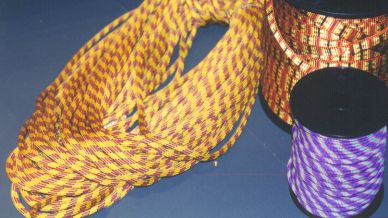![]() Download this document in PDF
format.
Download this document in PDF
format.
 A rope is
a bundle of fibres/threads/wires twisted together. So why not
just use a thicker single strand? While a single strand should
have the same strength as a rope of the same cross sectional area
there are several reasons why a rope is often a better solution.
A rope is
a bundle of fibres/threads/wires twisted together. So why not
just use a thicker single strand? While a single strand should
have the same strength as a rope of the same cross sectional area
there are several reasons why a rope is often a better solution.
Suspension cable |
Climbing rope |
|
| Required strength | high |
medium |
| Allowable weight | low |
low |
| Stretch Requirements | high Young's modulus |
high elongation |
| Flexibility | little required |
great |
| Impact toughness | medium |
high |
| Creep resistance | high |
low |
| Notes | Since these are used to suspend bridges the most important criterion is strength in tension. Because it is important that the bridge does not flex too greatly under strong winds or during the passing of large lorries, the stiffness (Young's modulus) must also be high. In addition, for very large span bridges the weight of the cables themselves is also important. For this reason a specific stiffness - specific strength chart (above) is useful for identifying suitable materials - the chart shows a selection of materials available as fibres. Until recently steel cables have been used for bridge type applications. Steel wire such as that used inside pianos (patented steel wire) can have a very high tensile strength, but it is quite heavy. Recently very high specific stiffness and strengths have been recorded for synthetic fibres. These are now used in suspension bridges by incorporating fibres into a matrix to form a composite bundle. This is then twisted with others to form a rope. Creep properties (the gradual extension over time under a tensile load) are also very important. | Unlike suspension cables, climbing ropes are not designed to be continuously under load. This means that creep is much less of an issue. Climbing ropes are primarily used in the event of a fall. If a climber should fall, then the rope must be able to stop the fall without breaking, but also without too rapid a deceleration (the opposite of acceleration) since this can also cause injury. This design constraint is met by requiring materials with a large elastic elongation before failure (see below). The weight of the material is also important - partly as a lead climber has the weight of the rope hanging below them, but also because climbing gear is often carried for large distances. Original climbing ropes were made of hemp - a natural fibre that is similar to cotton. Modern ropes are made of nylon, or combine a fibre core with a protective textile sheath (using nylon and rubber). |
Suspension cables require high Young's modulus and strength, but also low weight. Rather than using 2 selection charts, we can form specific properties that represent performance per unit weight. The chart opposite shows that many fibres have excellent specific properties - but of course these can only be exploited by building the fibres into a structured material like a rope or a fabric. The material bubbles in red show long-fibre properties; the other materials and material classes show bulk properties i.e. those you would expect if the material is not drawn into fibres. The strength for the bulk ceramics shown on the chart is compressive strength - the tensile strength is typically only 10% of this value; for the other materials the strength is similar in compression and tension; the strength for all fibres is for loading in tension.
|
Ranking candidate materialsTwo important material characteristics needed to satisfy the design requirements for climbing ropes are:
These quantities are not separate material properties, but depend on two familiar properties - strength and Young's modulus - as follows: elastic strain at failure = strength/Young's modulus elastic energy stored at failure (per unit volume) = ½ x strength x elastic strain at failure
|
|
|
| For parachute lines and climbing ropes, where safety is the most important requirement, designers apply what is called a "safety factor". If you design a product that has to be strong and design it to survive to 5 times the expected maximum load, this is a safety factor of 5. |
|
|